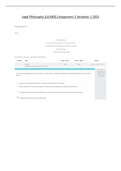Other
Assignment 10.1 - HCI Project 2024 Pearson BTEC - Distinction
- Course
- Institution
- Assignment 10.1 Distinction - Grade achieved: Distinction Year: 2024 Course: BTEC Computing Level 3 Extended Diploma Exam board: Pearson Unit: 10 Assignment: 1 Document type: Report Document file format: Word Document (.docx) DISCLAIMER: DO NOT submit this file as your own to your a...
[Show more]




